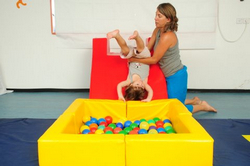3-7 years
Recommended exercises for ages 3-7 years:
Your child’s familiarity with various sports activities laying elements of pleasure and health for later in life. The exercises, the game and the mutual leisure with the parent improves his motor skills and supports the building and strengthening of his confidence which is essential for further physical, cognitive and emotional development
Examples for exercises that will help you, the parents and care takers, to reach the full potential of the GYMBOX.
The parent is responsible for the correct performance of the exercises.
No exercise should be attempted without the will and the cooperation of the infant.
All the precautions that are specified on the label that is glued to the product must be followed.
It is forbidden to play with the product or climb on it without adult supervision.
While in use, theGYMBOX must be placed on a carpet or soft surface.
The social game
The development of the social game is of primary importance. Encourage your toddler / child to play in cooperation with other children.

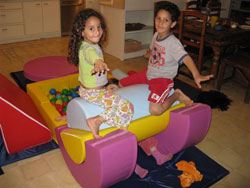
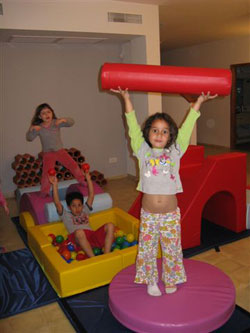
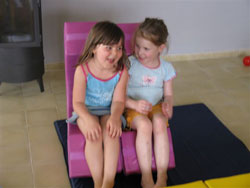
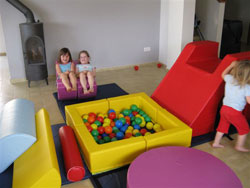
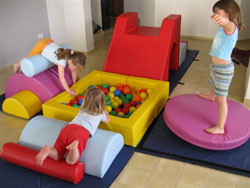

Development of balance skills by walking on a twisted beam
Accessory provided: two half circles connect to beam in a shape of S
Position of origin: Help the child to climb and to stand on a beam
The exercise: help the child by holding his hand to walk on the beam step by step until he walks balanced and independent. Explain to the child what to do and use clear terms such as: walking forward, step by step, walking backwards, spin around, standing on one leg.
Developmental contribution: walking on a twisted route develops the stability and the equilibrium in coordination between the functions of the hands and feet and the progress and the organization in the space. An additional value is acquired in the learning of movement concepts, walking forms and marching in different directions
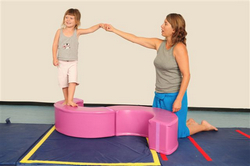
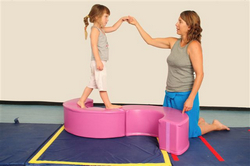
Developing the balance Skills and separation of body movements
Accessory provided: a swing consisting of two halves of a circle and two half-cylinder piled on each other.
Position of origin: Help the child to sit on the swing
The exercise: help the child to swing while separating the moves: upper part of his body and lower part of his body and to stabilize himself on the swing. Later on encourage him to perform this exercise on his own.
Developmental contribution: development of balance skills by the ability to separate movements, to coordinate between the upper part and lower part of his body, understanding the functions of hands and legs in different direction of the movement raises the physical awareness and contributes to the development of the sense of body control.

Developing the balance skills and the strengthening of the upper part of his body
Accessory provided: an overturned swing directed toward the balls pool and above it laying a roll
Position of origin: stand beside or behind the child and help him to put the chest on the roll.
The exercise: hold his hips or his legs in a wheelbarrow position and encourage him to rollover toward the pool while his hands are leading the movement, ask him to pick up a ball.
Developmental contribution: the walking in a wheelbarrow position helps to the strengthening of the neck muscles in the back and the Shoulder belt. Passing the weight which result due to the rolling toward the balls pool, strengthening the hands and the legs muscles and make the movements more flexible. Picking up a ball from the pool in this position contributes to the development of the coordination and the eye – hand coordination.
Development of the movements’ skills and balance by passing through obstacles
Accessory provided: stairs, half a roll, two halves of a circle connected to a circle
Position of origin: make an obstacle route by means of the stairs, halves of a roll and the circle
The exercise: stand beside the child and help him to climb and to pass between and above the “obstacles”, later on offer him to make a route of his own.
Developmental contribution: the climbing and the declining from different heights and the passing of obstacles in different distances require planning and organization of body movements in space, according to the form and the height of the “obstacle”, raises the awareness of the toddler to his different organs and their function and their motion ability and developing the posture. The creation of routes and passing through obstacles is a challenging and joyful environment for the development of the infant.
Development of the movements’ skills and balance by rolling to the side
Accessory provided: two halves of a circle connected to a full circle
Position of origin: help the child to get into the circle, the stomach and the chest are lying on the wall of the circle and his hands and legs are lying on the mattress.
The exercise: rotate the circle to both sides and later on guide him to roll to the side on his own ( pencil rolling)
Developmental contribution: developing the body senses in different lying positions and the passing among them: stomach – side – back. Circular motions that contributes to the awareness of different motion directions.


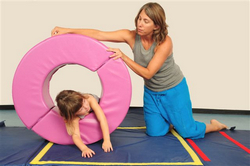
Balance and development of the motion skills by means of rolling backwards
Accessory provided: a slide / a slope and balls pool
Position of origin: help the child to sit with his back directed toward the balls pool , lay him carefully down on the slope while his head is pointing downward and his hands are holding the wall of the balls pool.
The exercise: Hold the child’s hips in front and in the back and help him to roll back.
Developmental contribution: the passing of the weight while rolling backwards improving the motorical motion abilities and adds to the flexibility of the body, this in a position less common : the head downwards and the lower part of the body leading the motion.
Performing a roll backwards on a slope helps to the later learning to perform a rolling back on the mattress.
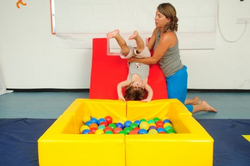
Development of balance Skills on an unstable surface
Accessory provided: balance surface
Position of origin: Help the child to stand on a balance surface while his hands outstretched to the sides.
The exercise: Hold the child’s hands and help him to move weight from one leg to the other while he is learning to balance and to stabilize himself, put your hands under his hands, touching but not touching, and when he performing the exercise on his own, put your hands down and stand beside him for supervision.
Developmental contribution: exercise and maintaining the balance on an unstable “surface” developing the posture and improving the motion abilities
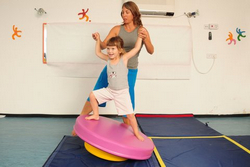
Development of balance skills by walking on a twisted beam
Accessory provided: two half circles connect to beam in a shape of S
Position of origin: Help the child to climb and to stand on a beam
The exercise: help the child by holding his hand to walk on the beam step by step until he walks balanced and independent. Explain to the child what to do and use clear terms such as: walking forward, step by step, walking backwards, spin around, standing on one leg.
Developmental contribution: walking on a twisted route develops the stability and the equilibrium in coordination between the functions of the hands and feet and the progress and the organization in the space. An additional value is acquired in the learning of movement concepts, walking forms and marching in different directions
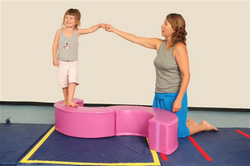
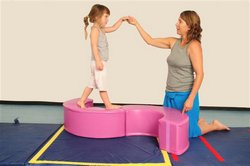
Developing the balance Skills and separation of body movements
Accessory provided: a swing consisting of two halves of a circle and two half-cylinder piled on each other.
Position of origin: Help the child to sit on the swing
The exercise: help the child to swing while separating the moves: upper part of his body and lower part of his body and to stabilize himself on the swing. Later on encourage him to perform this exercise on his own.
Developmental contribution: development of balance skills by the ability to separate movements, to coordinate between the upper part and lower part of his body, understanding the functions of hands and legs in different direction of the movement raises the physical awareness and contributes to the development of the sense of body control.

Developing the balance skills and the strengthening of the upper part of his body
Accessory provided: an overturned swing directed toward the balls pool and above it laying a roll
Position of origin: stand beside or behind the child and help him to put the chest on the roll.
The exercise: hold his hips or his legs in a wheelbarrow position and encourage him to rollover toward the pool while his hands are leading the movement, ask him to pick up a ball.
Developmental contribution: the walking in a wheelbarrow position helps to the strengthening of the neck muscles in the back and the Shoulder belt. Passing the weight which result due to the rolling toward the balls pool, strengthening the hands and the legs muscles and make the movements more flexible. Picking up a ball from the pool in this position contributes to the development of the coordination and the eye – hand coordination.
Development of the movements’ skills and balance by passing through obstacles
Accessory provided: stairs, half a roll, two halves of a circle connected to a circle
Position of origin: make an obstacle route by means of the stairs, halves of a roll and the circle
The exercise: stand beside the child and help him to climb and to pass between and above the “obstacles”, later on offer him to make a route of his own.
Developmental contribution: the climbing and the declining from different heights and the passing of obstacles in different distances require planning and organization of body movements in space, according to the form and the height of the “obstacle”, raises the awareness of the toddler to his different organs and their function and their motion ability and developing the posture. The creation of routes and passing through obstacles is a challenging and joyful environment for the development of the infant.
Development of the movements’ skills and balance by rolling to the side
Accessory provided: two halves of a circle connected to a full circle
Position of origin: help the child to get into the circle, the stomach and the chest are lying on the wall of the circle and his hands and legs are lying on the mattress.
The exercise: rotate the circle to both sides and later on guide him to roll to the side on his own ( pencil rolling)
Developmental contribution: developing the body senses in different lying positions and the passing among them: stomach – side – back. Circular motions that contributes to the awareness of different motion directions.
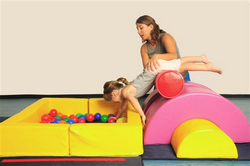
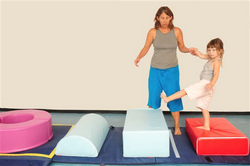
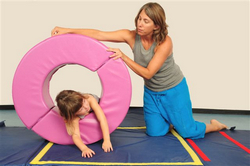
Balance and development of the motion skills by means of rolling backwards
Accessory provided: a slide / a slope and balls pool
Position of origin: help the child to sit with his back directed toward the balls pool , lay him carefully down on the slope while his head is pointing downward and his hands are holding the wall of the balls pool.
The exercise: Hold the child’s hips in front and in the back and help him to roll back.
Developmental contribution: the passing of the weight while rolling backwards improving the motorical motion abilities and adds to the flexibility of the body, this in a position less common : the head downwards and the lower part of the body leading the motion.
Performing a roll backwards on a slope helps to the later learning to perform a rolling back on the mattress.
